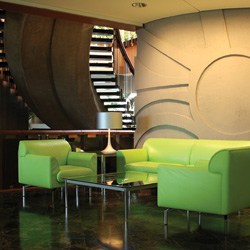
The conventional office environment is evolving to accommodate new ideas and ways in which business is conducted in today's age. Technology is shaping how we learn, communicate, store information and carry out daily functions.
Every day we learn more about the logistics of how people work and its direct influence on the built environment. Companies have a genuine interest in the well-being and quality of life of their employees. These factors are challenging designers to pay attention to the logistics of these factors in order to accommodate for the ever-evolving work environment. The built environment is starting to mold itself around how human beings operate, not forcing individuals into a space.
As a society, we are taking steps in becoming more responsible individuals when it comes to how space is used, budgeting our dollars, and learning to not take more than what we truly need. With financial concerns and green initiatives as driving factors, the footprint of the office environment is shrinking. And with spaces shrinking and walls encroaching, the office is becoming more efficient in how resources are being used.
A shift in trends is moving from the traditional private-office work environment. The office is opening up and walls are virtually non-existent. Large, status-related offices are shrinking, and space is being allocated where it is needed. The view of the new office space is an open, multi-functional, environment which promotes collaboration, effectiveness and flexibility. Employees are encouraged to work together to problem-solve, share ideas and utilize this collaboration as a tool for learning. This shift in trends is letting designers focus on making these work spaces better suited to fit the needs of the end user.
Technology is a wonderful tool that we use on a daily basis to complete tasks and functions. It heightens our capabilities and changes the way we work. The integration of technology into work environments provides many advantages for business owners and their employees. It makes it possible to work, communicate and perform tasks from virtually any location. With increasing demands and busy schedules, it has given workers the tools needed to stay connected to work. Often times, employees are spending less physical time within their office space. With the expenses of real estate, mobile technology is allowing companies to cut costs and allocate revenue elsewhere. With an increasingly mobile workforce, touchdown stations are becoming popular with many companies. These are temporary work areas, not assigned to any one individual—with less floor space, but more efficient and effective.
An office built for today's workplace consists of many well-thought-out design practices and theories. The choices within the built environment are taking an understanding of ourselves and how we function to new levels. Most importantly, we understand our future is ever-changing, progressing and innovating. These trends not only promote the office of today, they are preparing us for an office environment of tomorrow. iBi

